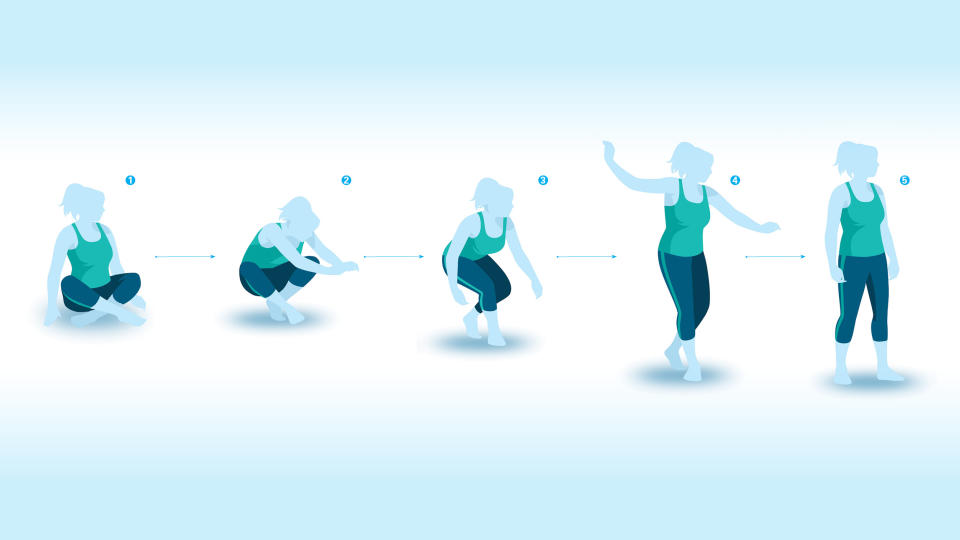Try This Quick Sit to Stand Fitness Test + See What the Results Say About Your Longevity
Believe it or not, your ability to stand up from a seated position on the floor may say a lot about your fitness level and overall health. This sit to stand fitness test is a simple (but not easy!) move with big implications.
“Flexibility, balance, strength and coordination are all involved in the movement—if you can do it, it shows a certain level of musculoskeletal fitness, which is important for longevity,” says Tom Holland, MS, CSCS, an exercise physiologist based in Darien, Connecticut, and author of The Micro-Workout Plan. “Balance and strength are so important as we get older. It’s about adding quality to our years.”
Related: Starting Your Day With This One Simple Move Thwarts Upper Back Pain, Doctor Says
Want proof? A study in the European Journal of Preventive Cardiology had more than 2,000 adults, ages 51 to 80, perform the sit to stand fitness test and found that people who couldn’t do it without using a hand or knee to support them had higher mortality rates (from any cause) over a six-year period. By contrast, those who could do this move comfortably, without support, had greater longevity.
How to do the sit to stand fitness test
This assessment calls on balance, strength and mobility — and kinesthetic awareness, which is neurological. After completing the move in both directions (from sitting to standing then from standing to sitting), note which part of the move challenges you most, so you can monitor progress.

1. Start in crisscross applesauce position
Sit cross-legged on the floor and push yourself up to a standing position, using only your feet, legs and core muscles.
2. Try not to use support
Avoid using your hands, knees or any other body parts to support you, but it can help to reach your arms out in front of you at chest level to steady yourself.
3. Take your time
Do this move slowly and with control; there’s no race against the clock or time limit for the test.
4. Use your core
As you rise, use your core to help you stand tall; you also may want to extend your arms to the side to help you balance.
5. And back to the beginning pose
Once standing, return to sit cross-legged on the floor, without using your hands.
Related: Research: Curiosity Is the Secret to All-Day Happiness — Here’s How to Unleash Yours
Were you able to complete the sit to stand test?
If you can do the move comfortably, without using your hands, knees or arms, you’ve aced it! “I don’t care how fast or how many times you do it,” Holland says. “Being able to do it is enough.”
Did you struggle?
Don’t stress. Even some athletes have trouble with this move, Holland says. There are many reasons it could be difficult for you (like limited range of motion in the pelvis). It’s just one measure of fitness and it’s a fun move to work on. You can work up to it by doing more squats and lunges. Also smart: walking and taking the stairs often.
Another way to build lower-body strength: Get out of a chair, then sit down without using your hands; repeat several times in a row, Holland suggests.
After doing these moves regularly for a few weeks, try the test again. If you’re still struggling, place one hand on a wall as you stand up, then lower yourself back to the floor. “Over time, work up to using less and less pressure with your hand,” Holland suggests, until you can do it hands-free.
Related: Working Out Is Boring — But These Childhood Exercises Aren’t (And They Make You Feel Like a Kid)
To increase the sit to stand challenge...
If you can do the test successfully, ramp up the difficulty and build strength and agility by doing the move with your hands behind your head. Or do a few reps at a time; once you can do that, try doing this move three to five times in a row. “It’s a meaningful goal,” says Holland. “This is a functional move. Being able to do it helps you avoid falling and helps you get up if you do fall.”
For more on how to boost your fitness, click through the stories below:
Fascia Exercises Are the 10-Minute Routine Helping Women Get One Size Smaller — Fast!
Expert Advice: ‘I’m Exercising More, But I’m So Sore. What Can I Do to Stop the Pain?’
